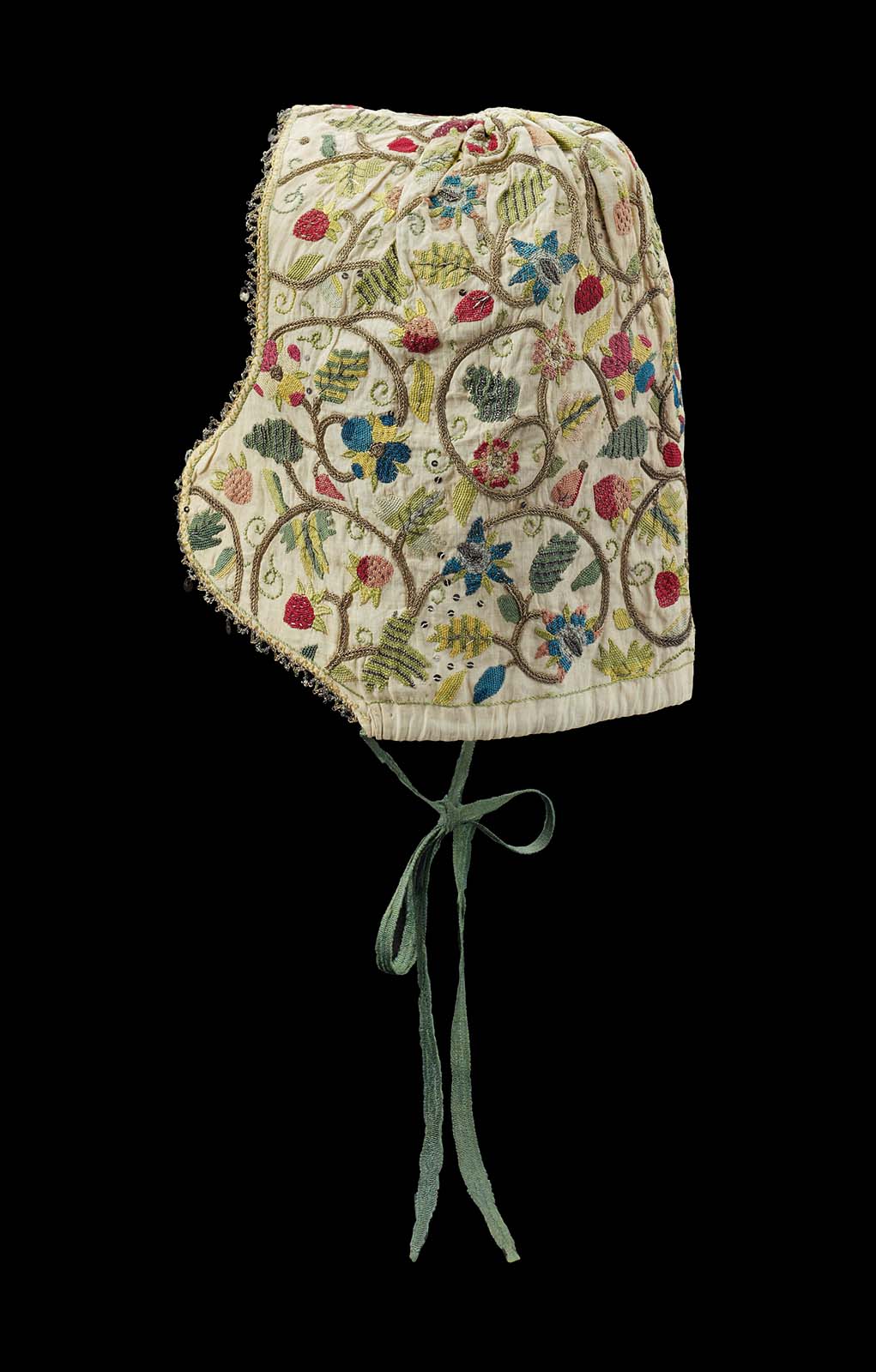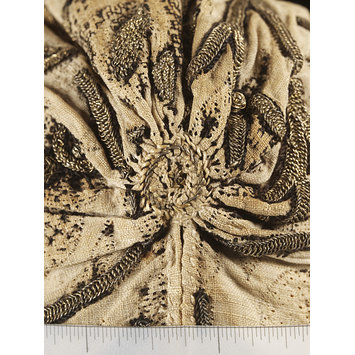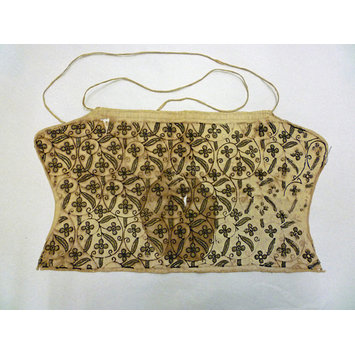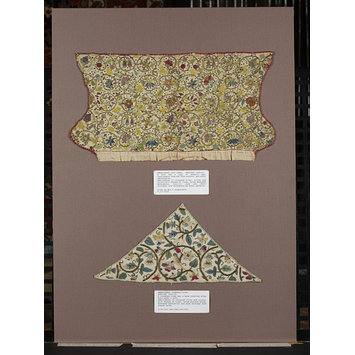 |
| 16th century style linen smock and petticoat for a very young child. |
Sunday, June 30, 2019
Petticoat and Smock for a Young Child, 16th Century
Smock from the basic drafting instructions in The Tudor Child, short-sleeved petticoat from the John Dench pattern in the same book. The smock is of mid-weight linen (5.3 oz); the petticoat is made from remnants from my gown; both close with 1/4" linen tape ties.
Wednesday, June 26, 2019
Wimple Wednesday: Cap With Folded Brim, Early 17th century
Lace-edged cap with turned-back brim, c.1615-1625, from Patterns of Fashion 4. The shape is almost identical to two children's caps of 1608 and 1620 in The Tudor Child.
I'm still working out how to best fit my hair until this cap; the coronet braids seem to work best, but I need to fine tune the placement. And then persuade them to stay put. I'm enjoying the lace, though.
The cap is made from a single piece of 3.5 oz lightweight linen from Fabric-store.com, the lace is from The Tudor Tailor store.
 |
| I rather like how this cap turned out. |
 |
| Even if it looks silly because my hair wasn't cooperating. |
Wednesday, June 19, 2019
Wimple Wednesday: 16th Century Flemish Coif
The original has c.1590s Italian lace, but is described by the VAM as a Flemish style c.1550-1600. Interestingly, the portrait mentioned in the MET's description of this coif is dated c.1530--as are several other portraits by the same artist showing this style of coif. So, we're looking at a style that was apparently in use at least from 1530-1600.
From the item description, the coif is 39.5" long from crown to lappet and 9" wide at maximum (which I believe to be the front-to-back measure). There appears to be a seam along the top, which is gathered into the 'rondel' at the back. This is very like the construction of last week's coif, only with lappets and no back gathering.
When worn, the lappets appear to be crossed or pinned up at the back, making folds and a separation between the hanging lappet and the coif where it sits over the head. Crossing and knotting the lappets behind caued the coif to pull away from the head. I am still experimenting, but tentatively favor crossing the lappets high behind the head, and pinning each one.
Of course, it is very easy to tie the lappets over the head, like the 15th century long-tailed cap, and I rather like it. Pity the portraiture disagrees.
| Portrait of Anna Codde (1529) by Maerten van Heemskerk |
| Portrait of Emmetje Teunisdr. van Souburgh (1540-1545) by Maerten van Heemskerck |
When worn, the lappets appear to be crossed or pinned up at the back, making folds and a separation between the hanging lappet and the coif where it sits over the head. Crossing and knotting the lappets behind caued the coif to pull away from the head. I am still experimenting, but tentatively favor crossing the lappets high behind the head, and pinning each one.
 |
| Still working out the fold lines, but I think this is on the right track. |
Of course, it is very easy to tie the lappets over the head, like the 15th century long-tailed cap, and I rather like it. Pity the portraiture disagrees.
 |
| Comfortable, practical, and not supported by my current evidence |
Sunday, June 16, 2019
Late 18th Century Shifts
 |
| Shift/chemise, last quarter 18th century. Shown with stays and panniers LACMA |
Some notes I put together in preparation for actually making 18th century costume. One must, of course, start from the innermost layers, which usually translates into shifts and stays.
| Shift, French, 3rd quarter 18th century. The Met. |
| Shift, American, c.1780. The Met |
| Shift, American, 1780-1810. The Met. |
The construction is easier to see flat, as in this example from Williamsburg:
 |
| Shift c.1780-1810. Colonial Williamsburg |
There are more examples in the Williamsburg collection (the site doesn't direct link, but a search for "shift" turns up two more late 18th century, as well as some early 19th). The shifts all cut square, and flare towards the hem (sometimes achieved with gores); the necklines are rounded, and some are controlled with drawstrings; the sleeves vary between mid-bicep to upper elbow length, and have a square gore under the arm to allow movement. Some of the more sheer fabrics reveal a facing at the point where the sleeve is joined to the body.
Additional sources:
There is good research by Larsdatter. Kendra of Demode has a short timeline of original chemises. And here is nother example by Mara Riley (I love it when measurements of the original item is included!). Marquise.de has some cutting diagrams adapted from French and German sources.
Saturday, June 15, 2019
Resource: Scissors and Yardstick (1872)
Look what's now available online: everyone's favorite guide to mid-late-19th century fabrics, colors, and dyes.
Wednesday, June 12, 2019
Wimple Wednesday: 16th Century to 17th Century One-piece Coif
Based off the nine c.1590-1620 coifs in Patterns of Fashion 4, not to mention most of the ones in my research post. The coif is cut out flat, in a stylized tulip shape: the flat edge near the flared sides is seamed together, with the center portion gathered, while the opposite side has a cord run through the middle portion, for gathering about the back neck.
I scaled it up some, since the largest coif in the book waas comically small once my hair came into play. I like where it sits along the hairline, but fear it's a touch too long along the sides (the rounded sections should be sitting closer to the ear than they currently are.
 |
| Still not got at this 'selfie' thing. Perhaps I can train the cats to take flattering pictures.... |
I scaled it up some, since the largest coif in the book waas comically small once my hair came into play. I like where it sits along the hairline, but fear it's a touch too long along the sides (the rounded sections should be sitting closer to the ear than they currently are.
Sunday, June 9, 2019
Lace Designs and Handwriting Samples 1604-1616
Italian, 1616 with one plate from 1604.
Just saving this here for reference (and because two lace orders arrived yesterday, leaving me with Feelings about natural fiber versus synthetic laces, as well as the visual and tactile differences between 16th and 19th century lace styles).
Just saving this here for reference (and because two lace orders arrived yesterday, leaving me with Feelings about natural fiber versus synthetic laces, as well as the visual and tactile differences between 16th and 19th century lace styles).
Friday, June 7, 2019
Original Coifs
My attempts to locate surviving forehead cloths (for shape and dimension details) met some success--and a good number of coifs. All appear to be the 'single piece' construction, and many have delightful embroidery.
| Venetian cap/coif, first quarter of the 16th century. From The Met. |
| Late 16th century British coif, from the Met. |
| Another embroidered coif, last quarter 16th century, from The Met |
 |
| Coif, c.1600, laid out flat. MFA Boston |
 |
| Polychrome coif, English, late 16th-early 17th century. MFA Boston |
 |
| Two blackwork coifs, British, c.1575-1599. VAM. |
 |
| Detail of coif, 1575-1599. VAM |
 |
| British coif, c.1600-1625. VAM. |
 |
| Coif, 1590-1610. VAM. |
Forehead Cloths:
 |
| Coif and Forehead Cloth, c.1610-1615. MFA Boston. |
 |
| Coif and Forehead Cloth, British, 1620-1640. VAM. |
| Triangular forehead cloth, embroidered, last quarter 16th century, in The Met. |
| Another forehead cloth, last quarter 16th century, from The Met. |
Thursday, June 6, 2019
HFF 3.12: Picnic
The Challenge: Picnic. Make a food for travel or eating outside.
The Recipe: Chicken Salad from the Ladies' Indispensable Assistant. Beeton's infamous picnic menu for 40 persons calls for multiple lettuces and baskets of salad after all...
The Date/Year and Region: 1852, New York
How Did You Make It: Picked and washed lettuce (heritage rouge de l'hiver and oakleaf varieties, I think), then chopped it small and arranged it on the platter. Cut two half-breasts of chicken fine and fried them, flavoring with salt and pepper. Boiled four eggs. Arranged the chicken on the lettuce. Sliced the eggs, removed the yolks, and arranged the whites around the chicken. Rubbed egg yokes through a sieve, then stirred in ~2 tsp salt, 4 tsp mustard, 4 Tbsp oil, and ~6 oz apple cider vinegar. Poured this dressing over the chicken.
The receipt called for celery, but allowed lettuce as a substitute.
Time to Complete: Not sure, but it didn't seem very long.
Total Cost: $3.50 for chicken (on sale), everything else was on hand or in the garden
How Successful Was It?: I liked it, even though I ended up making too much dressing for the amount of chicken and lettuce. The mustard flavor is dominant in the dressing, but the egg and vinegar add some complexity to it. I probably should have added more vinegar (1 wineglass full per egg seems to be about 2 oz minimum), but I thought the acidity of the dressing was pretty good (though it was a touch thick).
Despite being similar to Beeton's receipt, I liked how the dressing made this one taste different. It was also simpler the make, having no beetroot, cucumber, or endive to worry about.
How Accurate Is It?: My modern shortcut was using commercial mustard for the 'prepared mustard'; I expect the chicken was meant to be left-over from another dish, but not having any, I just pan fried some with salt and pepper. It's easy to do, but I have not documented the technique to this period (roasting and boiling being the methods I see most often).
 |
| Sieving egg yolks. |
 |
| Salad. That is a dressing of egg yolk and mustard, not melted cheese. |
Wednesday, June 5, 2019
Wimple Wednesday: Mid-Late16th Century Coif and Forehead Cloth
Brimmed Elizabethan coif with forehead cloth The Tudor Tailor. As previously noted, the sewn construction may be anachronistic. It is a fun shape, though.
I made this up in lightweight linen (Fabric-Store.com's 3.5 oz stuff), double layer construction, but without wiring the brim. As with the Henrician coif, I decided to see how it would hold up without the wire, and add it later if needed. I used a mid-weight linen on the first one, so it really doesn't need the extra structure; this one, being lighter, could use it, but a good ironing also works.
 |
| The coif has a fun, pointy brim. I'm just sad thinking about the June Rebellion. |
I made this up in lightweight linen (Fabric-Store.com's 3.5 oz stuff), double layer construction, but without wiring the brim. As with the Henrician coif, I decided to see how it would hold up without the wire, and add it later if needed. I used a mid-weight linen on the first one, so it really doesn't need the extra structure; this one, being lighter, could use it, but a good ironing also works.
Tuesday, June 4, 2019
Green Gown, 16th century
Another long-time project finally complete. Basic gown, from The Tudor Tailor, with wide turn-back sleeves, side-front (pinned) closure, and rectangular skirt panels. The bodice is lined with canvas; the dress is completely hand-sewn.
I'm going to see how the hemmed sleeve turn-backs work out, but I am inclined add a facing there.
Further reading suggests that I should have made this in wool, and I'll keep that in mind for the future. This linen, however, is such a delightfully horrid shade of green, that I think I'll simply have to wear it anyway. Says a reliable judge of matters sartorial and gallinaceous: "That goose-turd green is straight out of a Bruegel painting".
Further reading suggests that I should have made this in wool, and I'll keep that in mind for the future. This linen, however, is such a delightfully horrid shade of green, that I think I'll simply have to wear it anyway. Says a reliable judge of matters sartorial and gallinaceous: "That goose-turd green is straight out of a Bruegel painting".
Sunday, June 2, 2019
Another Batch Of Chemises
Haven't given up on Victorian clothing, just slogging through a round of repairs, alterations, and less-than-fascinating underthings. It's almost enough for me to start a survey of wear patterns...
 |
| The fascinating world of white cotton undergarments. With these, I'm now up to a total of two untorn chemises. |
Saturday, June 1, 2019
Original: 1827 Sheer Dress
 |
| English Gown, c.1827, from LACMA |
I really like the self-fabric decorations around the hem.
Subscribe to:
Comments (Atom)

